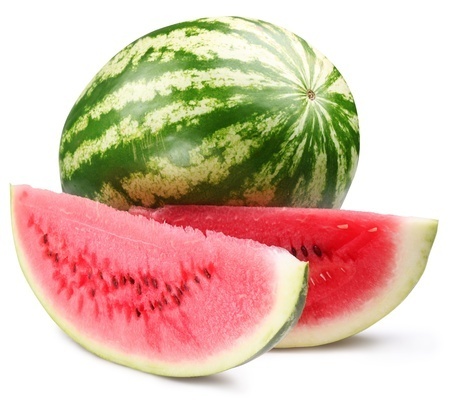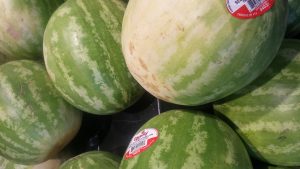
Watermelon (Citrullus lanatus) is possibly one of the largest fruit and vegetables you will ever find in the marketplace. It’s a firm favourite of anyone looking for a refreshing and tasty treat especially on a hot summer day. For many of us one bite evokes memories of syrupy drips on the chin.
The fruit is very common in West Africa such as Ghana, Nigeria and the Cameroons. It is now being grown throughout the Middle East because it is an effective source of oil and seeds. Africa is the cradle of the watermelon. It was being grown at least 5,000 years ago and there are records in ancient Egyptian papyrus of it being cultivated around 2,000 B.C. It was even buried in various Pharoah’s tombs to sustain and nourish the great leader into the afterlife.
It is a gourd and related to other melons, courgettes and squashes such as pumpkin which makes it a member of the Curcurbitaceae family. The melon is actually a berry which grows on a large flowering vine. There are 1,200 varieties and cultivars and many are characterised by the colour of the flesh. We have seen colours from red and pink through to yellow and orange. The rind might be striped or solid in varying shades of green, not to mention a number of shapes, sizes, and seeded or not seeded.
Watermelon Nutrition
It has a sweet flavour with numerous seeds and is a superb low-calorie treat. The fruit is mostly water, 91% to be precise with the remainder being largely carbohydrate (7%). This means it has a very low carbohydrate content. From an energy point of view, a one-cup serving contains but 46 calories but it will still provide about 18% of the Daily Value (DV) of vitamin A and 21% of vitamin C. For all you nutritionists, vitamin A is critical for protecting and maintaining our vision whilst vitamin C is a very effective antioxidant and needed for maintaining skin and collagen integrity.
Not only is it high in fiber it is also a fine source of various antioxidants such as lycopene. Lycopene is well documented for its association with health benefits including reducing the risk of cardiovascular disease and cancer and improving general health.
Eating watermelon is supposed to generate a slight diuretic effect. It is used by many in folk medicine for treating dropsy and renal or kidney stones. It is also associated with reducing hypertension, for treating an enlarged liver, jaundice and giardiasis.
Watermelon is also a source of citrulline which is associated with improvements in the health and functioning of blood vessels, overcoming for want of a better word with erectile dysfunction and diabetes. The flesh also contains small amounts of polyamines such as spermidine and spermine along with their precursor, putrescine.
It is a source of vitamins A and C and minerals potassium and magnesium.

Watermelon Seeds And Seed Oil
The seeds are a health food in themselves. They are consumed readily in India where they are known as tarbooj ke beej in Hindi. They are not easy to chew but are high in nutrients but low in calories.
This oil is commonly used in west Africa where it is known as kalahari, bereff oil or ootanga oil.
The oil is a great alternative to avocado oil because its nutritional value is bolstered by having low molecular weight saturated fatty acids. The composition is also similar to sunflower oil where it is made up of linoleic acid (43%), oleic acid (27%), stearic acid (19.5%) and palmitic acid (5%). The iodine content is 28.51g/100g oil which is typical for seed oils. Having a relatively low iodine value means it has good oxidative stability on storage. The residue remaining following extraction is about 47% protein
The seed oil is prepared most often by cold pressing the seeds. If hexane extraction is used which is a common industrial practice, then a recovery of 50%w/w is often commercially obtained (Moaddabdoost Baboli, & Safe Kordi, 2010). More modern, less toxic extraction methods use supercritical fluid extraction with supercritical CO2 (SC-CO2). The seed oil from this type of extraction contains 75% unsaturated and 25% saturated fatty acids (Rai et al., 2015).
The oil is also used in consumer products such as foaming agents, as a shoe polish, for creams, paints and some other industrial products where a high saponification oil is required. here it acts in a similar manner to linseed oil. The oil also flows well and spreads evenly onto surfaces .
When the seeds are roasted, they develop a well rounded slightly smoky note. the best way to prepare them is similar to other seed products. Simply spread the seeds on a baking tray and place in the oven at 325 Fahrenheit for nearly 15 minutes. the seeds become crispy and develop a red-brown hue. Whilst roast improves flavour, some of the nutrient is lost but they do make for a great snack. Adding some olive oil or rapeseed oil along with some salt and pepper to taste actually creates a wonderful snack. They are also great as garnishes for salads but depending on the country, are often used as garnishes, condiments, as thickeners for soups and broths, as a flavouring agent and even as a fat binder.
Watermelon seeds are full of nutrients such as magnesium, zinc, potassium and various B vitamins. They also contain plenty of fat and protein. Removal of the tough black shell improves their palatability. They are best sprouted if you want to obtain their protein.
To sprout seeds, soak in water overnight and wait for the seeds to sprout by placing on a clean white paper. They are best dried in an oven or dehydrator although in tropical climates, sum drying is perfectly fine. Again sprouted pumpkin seeds make a great snack.
The seeds also produce a reasonably good flour when defatted and a protein isolate is possible.
Watermelon rind should not be discarded as it contains polysaccharides which are inhibitors of angiotensin I-containing enzyme (ACE). This implies that the rind could offer a potential source of blood-pressure lowering materials and ingredients.
Products Based On Watermelon
Please note this page contains links to our affiliate marketing partner. Please read our affiliate disclosure.
References
Moaddabdoost Baboli, Z., & Safe Kordi, A. A. (2010). Characteristics and composition of watermelon seed oil and solvent extraction parameters effects. Journal of the American Oil Chemists’ Society, 87(6), pp. 667-671.
Rai, A., Mohanty, B., & Bhargava, R. (2015). Modeling and response surface analysis of supercritical extraction of watermelon seed oil using carbon dioxide. Separation and Purification Technology, 141, pp. 354-365 (Article).
Why does a watermelon have to be so big ? I really want to grow these up in Scotland but it’s just impossible to even get the seeds to sprout. Hopefully our world will get warmer and we can all grow these wonderful fruit around Kelso.